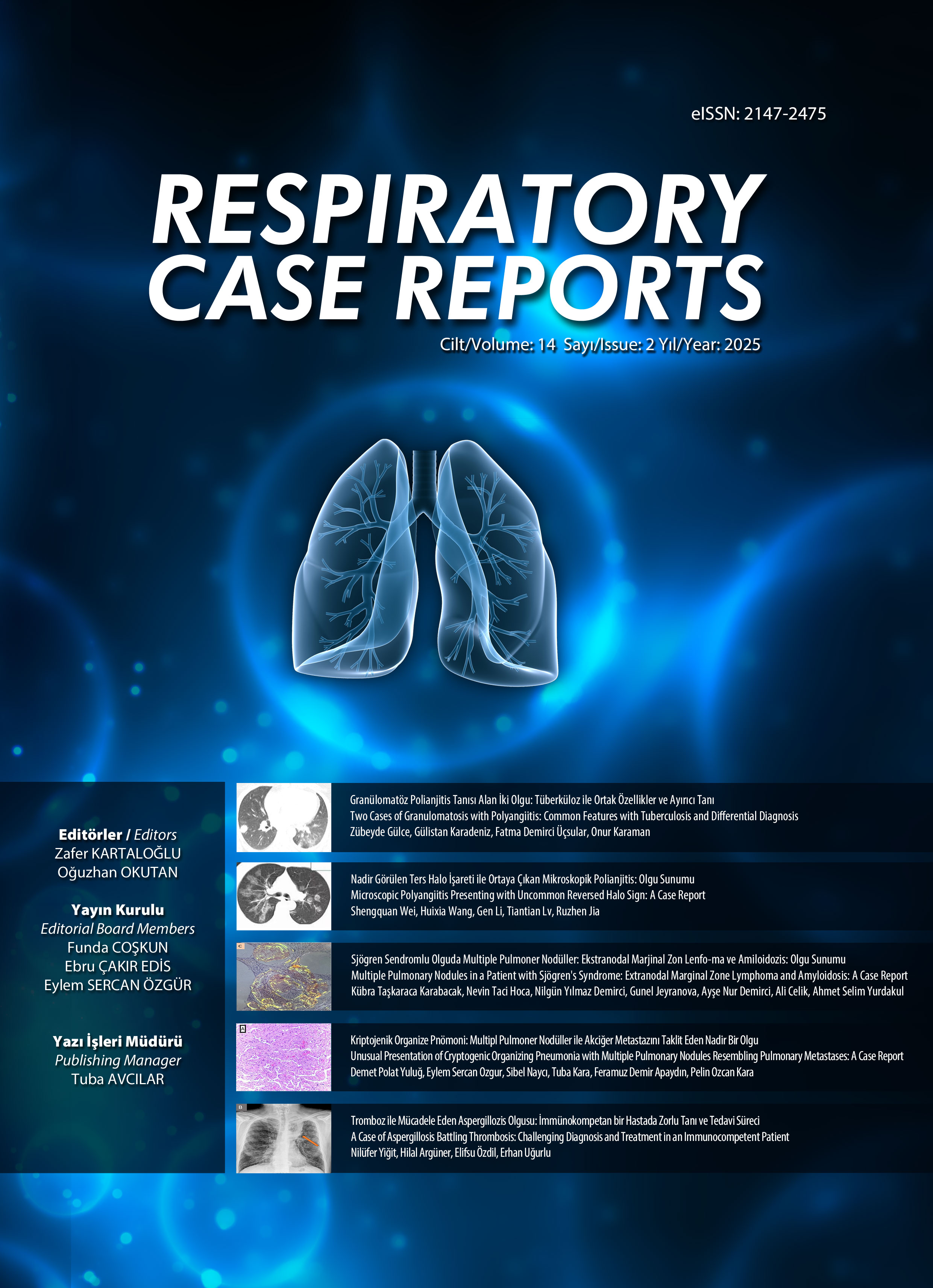e-ISSN 2147-2475

Volume: 9 Issue: 1 - February 2020
| CASE REPORT | |
| 1. | Differential diagnosis of anechoic images in Endobronchial Ultrasound Ester Cuevas, Yuliana Pascual-González, Nikos Koufos, Antoni Rosell, Noelia Cubero doi: 10.5505/respircase.2020.04834 Pages 1 - 3 In the present pictorial study, we report on four different cases with Endobronchial Ultrasound anechoic images, taken during a mediastinal lymph node study. Each anechoic image had a nodal coagulative necrosis sign. Although the anechoic images had similar characteristics in all cases, the final pathology report was different, with two cases positive for malignancy, one case showing a benign tumor of thyroid gland origin, and one case with tuberculosis. All patients signed informed consent for investigation with the EBUS technique. The procedure was performed in accordance with the regulations of our hospital, and following the usual technique followed in diagnostic mediastinal pathology studies. |
| 2. | Approach to Foreign Body Aspiration in an Infant Using a Cryoprobe Mohammad Ashkan Moslehi doi: 10.5505/respircase.2020.09226 Pages 4 - 7 Foreign body (FB) aspiration is a true medical emergency that occurs due to airway obstruction in which immediate removal is crucial. Rigid bronchoscopy is the preferred method for the removal of foreign bodies lodged in the airways, however studies have found that a flexible bronchoscopy can achieve greater success rates. Recently, although there have been reports of a cryoprobe being used for the removal of FBs in adults, in pediatrics, and especially in infancy, there is little experience about its use, in that tracheobronchial FB aspiration is an infrequently encountered event among neonates and in early infancy. This report highlights the efficacy of using a cryoprobe for a flexible bronchoscopy for the management of a retained FB in a young infant. |
| 3. | Hyponatremia, Cardiac Tamponade and Carcinoembryonic Antigen in Lung Adenocarcinoma Didar Şenocak, Tezcan Kaya, Kubilay İşsever, Ensar Özmen doi: 10.5505/respircase.2020.48378 Pages 8 - 11 Cardiac tamponade and severe hyponatremia are life-threatening and significant clinical findings. Severe hyponatremia, carcinoembryonic antigen (CEA) levels above 1000 ng/mL and cardiac tamponade are rare conditions as initial findings of non-small cell lung cancer. We report a 60-year-old man who presented with a cough, shortness of breath, nausea and loss of weight. The CEA level of the patient was 1041 ng/mL. He also had severe hyponatremia and cardiac tamponade. The patient was diagnosed with metastatic lung adenocarcinoma following an evaluation. The patient underwent chemotherapy treatment, but died 4 months after the cancer diagnosis. Severe hyponatremia, very high levels of CEA, and cardiac tamponade as initial findings of lung adenocarcinoma may be predictors of higher stage disease and poor prognosis. |
| 4. | A Case of Asymptomatic Pulmonary Limited Granulomatosis with Polyangiitis Dilaver Taş, Saime Ramadan doi: 10.5505/respircase.2020.48802 Pages 12 - 15 A 50-year-old female patient was admitted to the Obstetrics and Gynecology Department with vaginal bleeding. The patient was diagnosed with uterine myoma, and an operation was scheduled. A chest radiography revealed suspicious bilateral nodules during the preoperative evaluation of the patient. A thoracic computed tomography revealed bilateral nodular lesions in the superior segment of the right lower lobe and the posterobasal segment of the left lower lobe. A core needle biopsy of the right lung revealed a granuloma formation, neutrophil and lymphocyte infiltration, and fibrinoid necrosis in the interstitial and perivascular area. c-ANCA positivity was detected in autoantibody tests. Eyes, ears, nose, mouth and nephrological examinations of the patient revealed no pathology. The patient was diagnosed with Pulmonary Limited Granulomatosis with Polyangiitis, based on the present findings. Treatment with low dose weekly oral methotrexate, prednisone and folic acid was planned. The patient underwent a total abdominal hysterectomy and a bilateral salpingo oophorectomy without complications. The case is presented with a literature review given the asymptomatic status of the patient and the rarity of the disease. |
| 5. | Concurrence of a Large Parosteal Lipoma and Osteochondroma on the Chest Wall Abdulkerim Bayülgen, Ali Hızır ARPAT, CUMHUR TULAY doi: 10.5505/respircase.2020.72691 Pages 16 - 19 Chest wall tumors are very rare, accounting for 3.265% of all thoracic neoplasms. Chest wall tumors may originate from superficial or deep soft tissues, and from bone and cartilage structures. Lipoma is the most frequent benign tumor of the soft tissue, and those localized on the chest wall are often well-demarcated and larger than those that are superficial. A lipoma that is in contact with the bone is referred to as a parosteal lipoma. Osteochondroma (OC) is a common benign primary tumor of the bone that generally occurs between the ages of 10 and 30 years. It is often seen in the long bones, and costal localization is rare. We present here the case of a 28 year-old female patient who developed a parosteal lipoma with intercostal extension together with osteochondroma in the neighboring bone. |
| 6. | A Case of Granular Cell Tumor of the Mediastinum Treated by VATS and A Review of Literature Şevki Mustafa Demiröz, Göktürk Fındık, Gülşen Yılmaz, Funda Demirag, Pınar Tarı doi: 10.5505/respircase.2020.47123 Pages 20 - 24 Granular cell tumors (GCT) of mediastinal origin are extremely rare. To the best of our knowledge there have been a total of 21 cases reported since the first case was reported by Harrer in 1972. Both benign and malign forms of GCTs have been reported, and some criteria for malign forms have been described. Preoperative diagnoses are challenging due to the rareness of the condition. Histopathological studies should include immunhistochemistry. Given the rareness of such tumors in the mediastinum, the findings and the diagnostic yield of PET-CT are still unclear. Herein we present the case of a 50-year-old woman suffering from back pain whose diagnosis was based on a thorax computed tomography followed by PET-CT, and who was treated with a video-assisted thoracic surgical excision, with a final pathologic diagnosis of a granular cell tumor of the posterior mediastinum. |
| 7. | Primary Sternal Tuberculosis Mimicking an Anterior Chest Wall Tumor: A Case Report Ayşe Bahadır, Mediha Gönenç Ortaköylü, Belma Akbaba, Levent Cansever, Mehmet Ali Bedirhan, Efsun Gonca Chousein doi: 10.5505/respircase.2020.71676 Pages 25 - 28 Sternal osteomyelitis resulting from tuberculosis (TB) is a clinical rarity, occurring in only 13% of all cases of osteoarticular TB. Diagnosis is difficult and is often delayed due to atypical presentation and a lack of awareness. Magnetic resonance imaging (MRI) may be useful in the early stages and in atypical presentations. A 23-year-old female admitted with a 6-month history of chest pain and a mass on middle sternal part of her chest. A computerized tomography (CT) of the thorax and MRI showed a 33x28x42 mm soft tissue mass that was eroding the corpus sternum. Deep biopsy samples from lesions were obtained, and pathology revealed multiple granulomatous and necrotic lesions that were consistent with tuberculous osteomyelitis. The possibility of sternal TB should be kept in mind in the differential diagnosis of masses involving the chest wall, particularly in endemic areas. Herein, we report a case in which a sternal mass mimicked a chest wall tumor that was finally diagnosed as primary sternal tuberculosis. |
| 8. | Organizing Pneumonia Due To Crohn's Disease: A Case Report Melike Yüksel Yavuz, İbrahim Onur Alıcı, Ceyda Anar, Filiz Güldaval, Melih Büyükşirin doi: 10.5505/respircase.2020.35582 Pages 29 - 33 Lung and intestinal diseases may coexist as a result of their common embryonic origin, autoimmunity, smoking and colon translocation. In patients with inflammatory bowel disease (IBD), pulmonary involvement is more common in patients with ulcerative colitis than in patients with Crohn's disease (CH). A 53-year-old female patient presented with pleuritic pain, dry cough and exertional dyspnea. Antibiotic therapy was initiated, but after the patient did not respond to treatment, a video-assisted thoracoscopy was performed, and a diagnosis of organizing pneumonia was made following the examination of the biopsy material. The radiological and clinical condition of the patient improved with corticosteroid treatment, and a diagnosis of Crohn's disease was made in the 18th month of follow-up. Interstitial lung diseases can be seen in IBD, related either to the disease itself or to the drugs used. Pulmonary pathologies may also occur prior to a diagnosis of IBD. Although organizing pneumonia is rare in CH, as in our patient, a subsequent diagnosis of CH may be made. |
| 9. | IgG4 Related Disease Imitating Cancer, Autoimmune and Infectious Diseases: A Case Report with Lung Involvement Onur Derdiyok, Nagehan Ozdemir Barisik, Sevinc Citak, Cansel Atinkaya, İrfan Yalçınkaya doi: 10.5505/respircase.2020.50455 Pages 34 - 37 Plasma cell granuloma (PCG) is a rare benign tumor that is difficult to distinguish from malignancy. The terminology associated with PCG is inconsistent, with tumors referred to in literature also as inflammatory pseudotumor, fibrous histiocytoma or fibroxanthoma. Diagnosis: clinical features, serum IgG4 level, radiology and histopathological findings should be evaluated together. We present a case here that is very rare and newly described in literature in which a male patient presented to our clinic with a complaint of hemoptysis, resection due to a lesion on the lung who was subsequently diagnosed with IgG4-related disease. |











